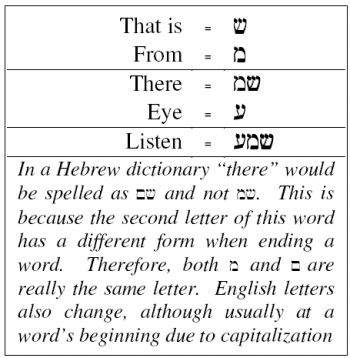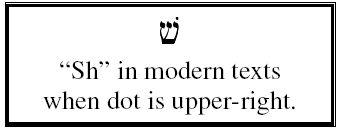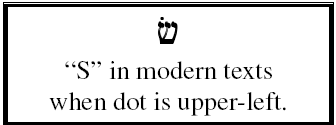Search our Archives:
» Home
» History
» Holidays
» Humor
» Places
» Thought
» Opinion & Society
» Writings
» Customs
» Misc.
|
When Lending an Ear is an Eye
By Chaim Gruber
“We have two ears and one tongue so that we would listen more and talk less.” ~ Diogeness
Hebrew letters each have meaning and a Hebrew word’s meaning is based on its letters.
(For instance, Hebrew’s word for “heart” is two letters; the first means “toward” and the
second “inside.”) With this in mind, and pertaining to Hebrew’s three-letter word for
“listen” (pronounced “shema”), by analyzing these letters one can actually learn how to!
The first two letters of “listen” literally spell a smaller Hebrew word meaning "there."
(Why? Because the first letter of “there” means “that is,” and the second means “from.”
“That is-from” equals “there,” for anything that is in any amount from, i.e., removed, is a
there!) The final letter of "listen" means an "eye." "Listen" is then "there-eye" in Hebrew!

Why? Because when listening to something one
turns to look. For instance, if from behind a
person there was a sound, how is it known that
such person listened to the sound? If the person
turned to see where the sound was coming from.
Due to this natural phenomenon, “listen” is
“there” (a sound from somewhere) followed by
“eye” (having a look).
Cleverly, “listen” equaling “there-eye” is
multifaceted: Imagine two persons speaking
face-to-face. If during this talk and due to
something being said, either the teller or listener
shifts his or her eyes away from the previous
stare to look at some “there” for a moment or for
a while, by nature something deeper is revealed:
If the teller’s eyes shift, it could mean that he or she had a lapse in memory and needed to
remember, or that the teller is even lying. If the listener’s eyes shift, it could mean that the
listener (or teller) has been caught in a lie. It could also mean something less sinister but
still revealing, such as due to what was just heard the listener had an idea. In fact, if the
listener’s eyes suddenly shift and remain away, it can be a sign that the listener had a great
revelation based on what was heard. This means that he or she was really listening!
Eye shifts can also reveal boredom, a painful topic of discussion, something overly complex,
low self-esteem, shame, etc. Pertaining to the speaker, in order to therefore be listened to,
one must also listen, that is, pay attention to such signs so that one can tailor the
conversation in order to be properly heard.
Sometimes eyes give a person away. Therefore, “there-eye” can also be how to listen to
what a person is really saying despite the words coming from his or her mouth. For
instance, if a parent asked a child if he or she hid a sibling’s toy and the child said “No!” with
eyes darting to a closet, the parent knows the real answer even before having a look.
Of interest, the three-letter word for “listen” starts with Hebrew’s twenty-first alphabetical
letter. This letter can actually be pronounced two ways, as a “sh” or “s.” The letter even has
two names: “Shin” when pronounced “sh,” and “syn” when “s.” (As “s,” this letter’s second
name is also spelled “sin,” although this author prefers the less ominous “s-y-n.”)
In more Modern Hebrew texts, this letter is pronounced “sh” or “s” depending on where a
dot is placed on the letter. With a dot on right, the letter is “sh.” If on left it is “s.”
However, Ancient Hebrew texts use no dots. Therefore, in an ancient text this letter can
be interpreted as either sound. “Listen” can then also be pronounced starting with a “s” and
not just a “sh” as in “shema.” This reveals another facet of listening, for pronounced this
other way, the first two letters of the word’s three-letters then spell a different, smaller
Hebrew word pronounced “sim,” that means “place” or “put down” as opposed to “there.”



“Listen” in Hebrew is then also “sima,” and also means “place-eye.” “Place-eye” is listening,
for placing an eye on someone is a sign that one is truly doing so. Just think of a parent
saying to a child, “Look at me when I speak to you!”
Not only to be respectful and pay attention do we place an eye, that is, stare so to really
listen, but also when doubting what someone is saying: Staring someone in the eyes when
he or she is giving an account is a way to tell if the person is speaking the truth: If the
person keeps his or her eyes fixed, it is a sign that the account is true. However, if the
person cannot, or pointedly blinks, blankly stares, etc., it is a sign of falsehood. This is so
because a lie ends somewhere: Even the best liar cannot make up a story for all the
potentially endless facts that would exist if what the person was saying was actually true.
Clever questions can then uncover what even the best liar forgot to consider. As soon as
this happens—when the liar has to reflect on something new—by nature there is a mental
pause somehow reflected in the eyes. After all, if a liar does not take time to think, the
whole story can be tripped up. Remember, however, if a committed liar is prepared, he or
she may be able to keep a stare. The trick is then a question that a liar is not prepared for.
While someone’s stare can naturally be broken due to reasons other than lying, if the person
if telling the truth, the person should be able to explain why his or her eyes turned in any
particular circumstance; say due to needing to recall, embarrassment, etc. Therefore, if
someone giving an account has no explanation for why his or her eyes averted, or it seems
like the person is trying to figure out what to say, that is a sign of lying. After all, if
someone shifts his or her eyes for some psychological reason other than lying, as one just
felt such an emotion one should be able to explain its cause.
“The eyes are the mirror of the soul.” No wonder this is a Yiddish proverb!
As mentioned, besides “place,” the word “sim” also means “put down.” Therefore, “listen,”
when pronounced “sima,” also means “put down-eye”. To understand this, imagine a
teacher scolding a student. If the student just defiantly stared back, such implies that the
student does not really care about what the teacher is saying, that is, the student is not
really listening, or is listening only to what he or she wants to hear. However, if a student
looks down when scolded (“put down-eye”), it is a natural sign of shame. This means that
the student is really listening as the teacher’s words are having an effect.
For the previous reason it can be considered disrespectful in some cultures to stare at an
authority figure. Furthermore, because by staring into the eyes one can discern profound
things, staring at an authority figure can put a youth in a position of judgment over an elder,
who, for instance, and for safety’s sake, may even be obligated to lie to a child.
“Put down-eye” even describes dogs listening! If two dogs were growling at each other,
when one then looked at the ground it was a sign of obedience to the other dog who must
have growled more ferociously. This means that the then obedient dog decided to listen!
Interestingly, in a famous Hebrew prayer called “Shema Yisroel,” its “listen” is traditionally
recited with eyes closed and covered. This is another way to listen, say as listening to
beautiful music with eyes shut, for the eyes being put away also puts away distractions. As
this prayer’s “listen” is pronounced “shema,” one is being directed to focus the eyes in order
to listen (“there-eye”). Paradoxically, as the eyes are closed when praying this word, “sima”
is implied. This is because the two-letter word “sim” in Hebrew can mean “put down” as in
being finished with something. Therefore, “sima”—“put down-eye”—can also be
understood to be putting away one’s vision so to better listen. This considered, by
pronouncing the word one way while physically acting it out another, the smart rabbi(s)
behind this tradition were saying that listening is multifaceted!
This famous prayer taken from Deut. 6:4 that starts with “listen,” has “Israel” as its
second word. In Hebrew, “Israel” is five-letters, with the dualistic twenty-first alphabetical
letter being Israel’s second letter. Therefore, in ancient texts without dots to determine
which way this letter is to be pronounced, “Israel” can also be “Ishrael.”
Perhaps funny to look at or hear, however, when pronounced this second way, “Ishrael”
literally means “straight toward” or “direct way”: * The name’s first three letters spell the
Hebrew word meaning “straight” or “direct,” and the final two letters spell the Hebrew
word meaning “way” or “toward,” as in “way of/toward the house.” Therefore, the first
two words of this prayer, often translated as “Hear O’Israel,” reveal eternal logic: That by
truly listening we go the direct route. After all, when not listening one does not know
exactly how to go or even where to go!

* That “Israel” can also be “Ishrael” seems clearly proven by Deut. 7:7, as it calls
Israel/Ishrael “the smallest of nations.” Therefore, as the Torah/Bible is meant to be true, how can
this statement possibly be so if what is being referred to is a person count? After all, the nation of
Israel was neither then the smallest of nations with so many having left on the Exodus, nor now,
with many millions of persons. Therefore, what this verse must be saying is that the nation of those
“directly toward” is the smallest of nations. Thusly understood, this verse is then eternal logic, for
those who go directly toward by nature have the least excess, as there is no beating around the
bush, misadventure, things unnecessary, frivolity, etc.
(The author, a Hebrew linguist, can be contacted via www.VeryEasyToRemember.com)
~~~~~~~
from the March 2009 Edition of the Jewish Magazine
|
|
Please let us know if you see something unsavory on the Google Ads and we will have them removed. Email us with the offensive URL (www.something.com)
|
|









